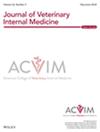Influence of Owner Personality and Other Owner-, Cat- and Treatment-Related Factors on the Perception of Quality of Life in Cats With Hyperthyroidism
Abstract
Background
Assessment of quality-of-life (QoL) is becoming increasingly important in veterinary medicine. In human medicine, it is known that the assessor's personality might affect QoL.
Objective
To evaluate the impact of owner personality and other owner, cat, and treatment-related factors on the health-related QoL (HRQoL) of hyperthyroid cats.
Animals
Five hundred hyperthyroid cats.
Methods
A prospective, cross-sectional, questionnaire-based study, conducted between April 2023 and February 2024. Owners completed the HyperthyroidismQoL-cat and the Big Five Inventory-2 to assess the cat's HRQoL and owner's five personality domains, respectively. Additional information about owner-, cat-, and treatment-related factors was collected. Univariable and multivariable linear regression modeling was used to assess associations between owner personality, other factors, and the cat's HRQoL. Significance was p < 0.05.
Results
In multivariable analysis, radioiodine treatment (RAIT; p = 0.001) and having a comorbidity (p ≤ 0.001) resulted in better HRQoL, whereas negative owner emotionality (p ≤ 0.001), having children ≤ 18 years of age (p = 0.04), treatment using a low iodine diet (LID; p = 0.023), no treatment (p = 0.03) and being hyperthyroid (p ≤ 0.001), hypothyroid (p = 0.004) or unknown thyroid status (p = 0.001) resulted in worse HRQoL.
Conclusion and Clinical Importance
When interpreting HRQoL data, the potential impact of the personality domain negative emotionality (tendency to experience anxiety, fear, negative emotions) should be considered. Based on HRQoL, RAIT is the treatment of choice, whereas LID or no treatment are the least favored options. These findings should be considered when counseling owners about their cats' hyperthyroidism and its management.


 求助内容:
求助内容: 应助结果提醒方式:
应助结果提醒方式:


